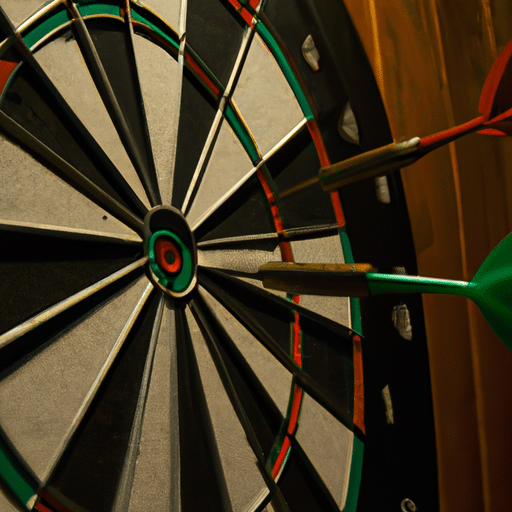Looking to have a blast with friends while enjoying some drinks? Look no further than the thrilling world of bar games! From the classic and precise aim of darts, to the strategic and skillful shuffleboard tables, to the high-energy and fast-paced challenge of foosball tables, these games are sure to keep you entertained for hours. So gather your crew, grab a drink, and get ready for some friendly competition as we explore the exciting world of bar games!
Darts
History of Darts
Darts is a popular bar game that has roots dating back to the Middle Ages. It is believed to have originated in England, where soldiers would throw short arrows at the bottom of wine barrels as a form of entertainment during their downtime. This eventually evolved into the game we know today as darts.
The modern game of darts became popular in the 19th century in English pubs. It was initially played with wooden arrows and feather flights, but over time, the equipment evolved to the standardized darts we see today. The game gained international prominence in the 20th century, with the establishment of professional dart tournaments and leagues worldwide.
How to Play Darts
Darts is a simple yet challenging game that can be enjoyed by players of all skill levels. To play, you’ll need a dartboard, which consists of numbered sections that are divided into different scoring zones. The objective is to throw three darts at the board and score points by hitting the desired targets.
There are various game variations, but the most common one is the 501 game. In this game, each player starts with a score of 501 and takes turns throwing three darts to reduce their score. The player must aim at specific sections on the board to score points, with the aim of reaching zero using the fewest number of throws.
To throw a dart, grip it firmly but not too tight, and stand at a distance of 7 feet 9.25 inches (2.37 meters) away from the board. Aim at the desired target and release the dart in a smooth and controlled manner. It’s recommended to practice your aim and throwing technique to improve your accuracy and consistency.
Different Types of Darts
Darts come in various materials, weights, and styles to cater to different preferences and playing styles. The most common type of dart is made of brass, with a steel tip and plastic flight. However, there are also darts made of tungsten, nickel-silver, and other alloys, each offering unique advantages such as better balance or improved grip.
Flights, the wings of a dart, also come in different shapes and sizes, affecting the trajectory and stability of the dart in flight. Standard flights are the most common type, providing a good balance between speed and stability. Slim flights are lighter and offer faster flights, while kite-shaped flights provide more stability.
Regardless of the type of dart you choose, it’s essential to find one that feels comfortable and suits your playing style. Experimenting with different weights and flight shapes can help you discover the perfect dart for your game.
Popular Dart Games
Darts is a versatile game that offers a wide range of game variations to keep things exciting. Here are a few popular dart games that you can try:
-
Cricket: In this popular game, the objective is to ‘close’ specific numbers on the dartboard while avoiding hitting your opponent’s numbers. The player who closes all the numbers first and has the highest score wins.
-
Around the Clock: This game is all about accuracy. Players take turns throwing one dart at each number from 1 to 20 in sequence. The first player to successfully hit all the numbers and the bullseye wins.
-
501: This classic game requires players to start with a score of 501 and take turns reducing it by hitting specific target areas on the board. The player who reaches exactly zero with the fewest throws wins.
-
Killer: A game of strategy and skill, Killer involves players taking turns throwing three darts and aiming to hit specific target areas on the board to accumulate points. The player who reaches a predetermined score first becomes the ‘killer’ and must aim to eliminate other players by hitting their numbers.
These are just a few examples of the numerous dart games available. Whether you’re a beginner or an experienced player, there’s always a game that can provide hours of entertainment and friendly competition.
Shuffleboard Tables
History of Shuffleboard
Shuffleboard, also known as deck shuffleboard, has a rich history that can be traced back to 15th century England. Initially played on the decks of ships during long voyages, shuffleboard provided a way for sailors to pass the time and enjoy friendly competition.
The game’s popularity grew, and it eventually made its way to land, where it became a favorite pastime in bars and pubs. Shuffleboard tables were specifically designed to recreate the surface of a ship’s deck, with the addition of scoring zones and markers.
How to Play Shuffleboard
Shuffleboard is a game that combines skill and strategy. The objective is to slide weighted discs, also known as pucks, along a long and narrow table, aiming to land them within scoring zones and accumulate points.
To play shuffleboard, you’ll need a shuffleboard table, which typically measures 22 feet in length. The table surface is smooth and coated with a layer of silicone or another low-friction material, allowing the pucks to glide easily.
Players take turns sliding their pucks, trying to get them as close as possible to the far end of the table without falling off. The scoring zones are divided into different sections, each offering different points. The areas further from the starting point usually have higher point values.
The strategy in shuffleboard lies in balancing accuracy, speed, and positioning. Players must assess the position of their opponent’s pucks and make strategic shots to block their scoring opportunities while maximizing their own chances of scoring.
Types of Shuffleboard Tables
Shuffleboard tables come in various sizes and designs to suit different preferences and spaces. The standard length of a shuffleboard table is 22 feet, but there are also shorter variations available for those with limited space.
In addition to size, shuffleboard tables can be made from different materials. Some tables are made of solid wood, such as maple or oak, which adds a classic and luxurious touch to any game room. There are also tables made from hybrid materials or synthetic surfaces, which are more durable and require less maintenance.
Furthermore, shuffleboard tables may have additional features such as electronic scoring systems or built-in storage for pucks and other accessories. Consider these factors when choosing a shuffleboard table to ensure it fits your needs and enhances your shuffleboard playing experience.
Famous Shuffleboard Players
While shuffleboard may not be as well-known as other competitive sports, there have been notable players who have made a name for themselves within the shuffleboard community. These individuals have shown exceptional skill and dedication to the game, inspiring others to take up shuffleboard and improve their abilities.
One such player is Billy Mays, a prominent figure in the world of shuffleboard. Known for his precision and strategic approach, Mays has achieved numerous victories in shuffleboard tournaments and is highly respected within the community. His consistent performance and commitment to the sport have made him a role model for aspiring shuffleboard players.
Mary Johnson is another shuffleboard player who has left a lasting impact on the game. With her incredible accuracy and ability to read the shuffleboard table, Johnson has won several championships and has received praise from both fellow players and spectators. Her success has helped raise awareness about shuffleboard and its competitive nature.
These famous shuffleboard players serve as a reminder that shuffleboard is not just a casual bar game but a sport that requires dedication, practice, and a strong strategic mindset. Their accomplishments inspire current and future players to continue pushing the boundaries of their own abilities and further develop the sport of shuffleboard.
Foosball Tables
History of Foosball
Foosball, also known as table football, has a fascinating history that dates back to the late 19th century. It is believed to have been invented in France by Lucien Rosengart, who wanted to create a game that replicated the excitement of football in a tabletop format.
The game quickly gained popularity, spreading throughout Europe and eventually reaching the United States. With its simple yet engaging gameplay, foosball became a staple in bars, game rooms, and recreational spaces worldwide.
How to Play Foosball
Foosball is a fast-paced game that simulates a soccer match on a small-scale tabletop field. The objective is to maneuver the miniature soccer players, known as foosmen, strategically to score goals against the opposing team.
To play foosball, you’ll need a foosball table, which consists of a rectangular playing surface with handles on each side. The foosmen are attached to rods that run across the table, allowing players to manipulate them by rotating the handles.
The basic rules are simple: each team has four rods, controlling the goalkeeper, defense, midfield, and attack positions. Players must work together to pass the ball, block their opponent’s shots, and ultimately score goals by maneuvering the foosmen into a favorable position.
Foosball requires quick reflexes, hand-eye coordination, and a strategic mindset. Mastering ball control, shot accuracy, and defensive tactics are key to becoming a skilled foosball player.
Different Foosball Table Types
Foosball tables come in various styles and designs, each offering a unique playing experience. Here are a few different types of foosball tables:
-
Home/Recreational Tables: These tables are designed for casual play and are often found in homes, game rooms, or bars. They are typically smaller in size and made of lighter materials, making them more portable and suitable for non-competitive play.
-
Professional/Competition Tables: These tables meet the official standards of recognized foosball organizations and are used in official tournaments and leagues. They are built with higher-quality materials, sturdy construction, and feature advanced ball control and goalie setups.
-
Outdoor Tables: As the name suggests, these tables are designed to withstand outdoor conditions. They are built with weather-resistant materials and have features such as moisture-resistant playing surfaces and sturdy construction to ensure durability.
-
Coin-Operated Tables: Often found in arcades or commercial establishments, these tables require the insertion of coins or tokens to start a game. They are designed for high-intensity play and are built with reinforced components to withstand heavy use.
The type of foosball table you choose will depend on your playing preferences, budget, and intended use. Consider factors such as the level of competition, durability, and portability when selecting the right foosball table for you.
Foosball Tournament
Foosball tournaments provide an opportunity for foosball enthusiasts to showcase their skills, compete against top players, and potentially win prestigious titles and prizes. These tournaments attract participants from various skill levels and offer a platform to foster community and sportsmanship within the foosball community.
Tournaments are organized at different levels, ranging from local events to international championships. The International Table Soccer Federation (ITSF) is recognized as the governing body for international foosball tournaments, establishing rules, regulations, and standards for competitive play.
Throughout the year, numerous foosball tournaments take place worldwide. These events offer different formats, such as singles, doubles, or team competitions, catering to players of all ages and skill levels. Additionally, there are specialized tournaments for specific foosball variations, such as goalie wars or speedball tournaments.
Participating in a foosball tournament provides a unique experience to interact with fellow players, learn new strategies, and compete against opponents from different backgrounds. Whether you’re a recreational player looking for a friendly competition or a serious competitor aiming for glory, foosball tournaments offer an exciting and challenging environment to test your skills.
In conclusion, whether it’s darts, shuffleboard, or foosball, bar games have a long-standing history of providing fun and entertainment in social settings. These games bring people together, fostering friendly competition and camaraderie. Understanding the history, rules, and variations of these games allows players to fully enjoy and appreciate the skill, strategy, and joy that they offer. So gather your friends, head to your local bar, and let the games begin!








































